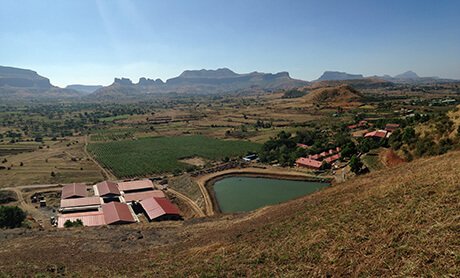Mantra Yoga has its origin in Vedic Sciences and also in Tantra, infact all the verses in Vedas are called mantras, it is said that any person who can chant or sing Vedas can achieve the ultimate salvation or union with supreme consciousness only by chanting the mantras, which is the aim Mantra Yoga.
MAN + TRA - Mantra is a Sanskrit word made up of two verbs, Man & Tra which in sanskrit "Mananat Trayate", just by chanting one can save himself in the universe that is achieve the ultimate in this material world.
EASIEST BUT SAFEST WAY TO PRATYAHARA or SENSE WITHDRAWAL - Mantra Yoga is a easiest way to achieve difficult state of Pratyahara, that is Internalizing the sense oriented mind from external world and focus on inner consciousness.
ACHIEVING SAMADHI (through rotation of consciousness) - When you chant Mantra, you are repeating the particular combination of words, which is rotating your awareness around the combination, this particular repetitive action leads to awakening powerful inner force, if controlled properly this can lead to ultimate salvation or union with super consciousness. One can compare example of concentrated sun beams in Convex lens, the rays / beams can burn a paper if lens is used, similarly the consciousness / awareness can be made concentrated and powerful by repetitive chanting of Mantra.
MANTRA - GROUPING OF SOUND VIBRATIONS (affect mental & psychological plane) Mantra is nothing but a combination or grouping of various alphabets / "Akshar" as is called in Sanskrit. The combined effect of sound vibrations on physical plane can be observed, specially on brain, or on EEG (Electro Encephala Graph) one can see the brain wave emission patterns affected with Omkar chanting, Gayatri Mantra chanting. A alpha activity in brain can be seen during the Mantra Chanting Also Mantra affects subconscious mind, it has different impressions on sub conscious, thinking patterns are affected, negative impressions can be removed from subconscious such as fear, anger, jealousy etc. also positive impressions can be programmed in the subconscious. Practice of Mantra increases concentration, memory, logical thinking.
Mantra Chanting has soothing effect on Nervous System, helps relax the muscles, can be effectively used to reduce stress and its effects.
GURU MANTRA OR IN DREAMS - In Sanskrit texts millions of mantras are there, so the question is how and what to choose? Guru is the best judge of the disciple, he knows his disciples inside out. So guru can select a best suited mantra which will help and evolve the disciple. Sometimes people see the Mantra in their dreams. But this is very rare phenomena.
UNIVERSAL MANTRA OM - If one can't meet his guru, he can select the universal mantra
MANTRA - NATURE of INDIVIDUAL - The selection of mantras is based on the nature of individual, his mind, physique and spiritual stage of development. For example :
Generally Mantras can be classified in 2 catagories
Total faith in Mantra - One must have complete faith in the mantra, without faith even the medicine is useless, so absolute belief is necessary before practicing mantras
o Yantra - psychic shape of mantra, an impression of mantra in the subconscious mind has great significance, one can focus on these during the chanting of the mantra and increase the effects of mantra or achieve the results faster. Popular Shree Yantra, Laxmi Yantra are also associated with related Mantras, it is said that if one focuses on the yantras, he still can get the same benefits as that of chanting the mantra.
Relaxed and concentrated state of mind - Due to withdrawal from the material thoughts, distractions, focusing of mind only on Mantra, mind is relaxed and becomes concentrated. Research shows the presence of alpha wave / rhythm of brain.
Rotation of consciousness around Mantra - Awareness is revolved round the mantra, its pronunciation, yantra (psychic shape) and its meaning, which builds up psychic energy which can then be used for spiritual purposes.
"Sakshi Bhav" - Attitude of unconcerned observer, this particular attitude is very important as it allows bypassing or witnessing disturbances arising in the conscious & sub conscious mind. Thoughts are generally very difficult to negotiate, this approach of "Sakshi Bhav" allows to overcome this problem.
Lost awareness of outside world - When practitioner goes deep in to the meditation states while chanting mantra, there is absolutely no awareness about happenings in surrounding environment.
Only Mantra awareness remains - Even there is no self, the mantra & its awareness is present when practitioner reaches higher states.
Baikhari (Audible) - By chanting a loud which can be heard easily is called "Baikhari" Chanting. Advantages of Baikhari Chanting
Upanshu (whispering) - Chanting of mantra in low voice, or just whispering so that only practitioner can understand is called "Upanshu" Chanting. Advantages of "Upanshu"
Manasik (Mental) - without chanting a loud or whispering, mantra is repeated in mind, this type of mantra chanting is difficult and can be learnt only with practice. Advantages of Mental Chanting
On personal level
On surroundings
One should have a Mala or Rosary consisting of 108 beads as is significant in all Tantra & Veda Texts.
Repeat Mala for 2 to 3 times daily (increase to even 8 to 10 hours) or Chant Mantra for at least 11 times.
Time of Practice - Morning or evening time
Pranayama during Mantra - Breath and Mantra (So ham with breath) One can chant the Mantra while exhaling or inhaling or both. While breathing a subtle sound of "So" can be heard and while exhaling "Ham", which is a repetition of Mantra "So Ham"
Concentration on object of faith - One should concentrate on following objects during the practice.
Selection - Name of GOD, Guru Mantra, in dreams, OM as universal mantra
Mala or rosary - 108 beads + 1 Sumeru (offset bead)
Types of mala :
Use middle finger and thumb only
Practice Mantra in meditative pose
Mala or rosary not visible to others
Japa Mala should not be worn
Do not cross sumeru (offset bead)
Hari Om
For Further Details please refer to -
Meditation fromTantras - Paramhansa Swami Satyananda Saraswati
Phone - +91-9822770727
E-mail - yoga@yogapoint.com or yogapoint108@gmail.com

Yoga Vidya Dham, Kaivalya Nagari,
College Road, Nashik - 422005.
Maharashtra, India.
Phone - +91-9822770727 (for courses in ENGLISH)
+91-253-2318090 (For courses, in HINDI or MARATHI)
(Please call during 9.00 AM to 5 PM Indian Time)
E-mail - yoga@yogapoint.co or yogapoint108@gmail.com
Village Talwade, Trimbak, Nasik
Maharashtra,India.
Phone - +91-9822770727
E-mail - yoga@yogapoint.com or yogapoint108@gmail.com
